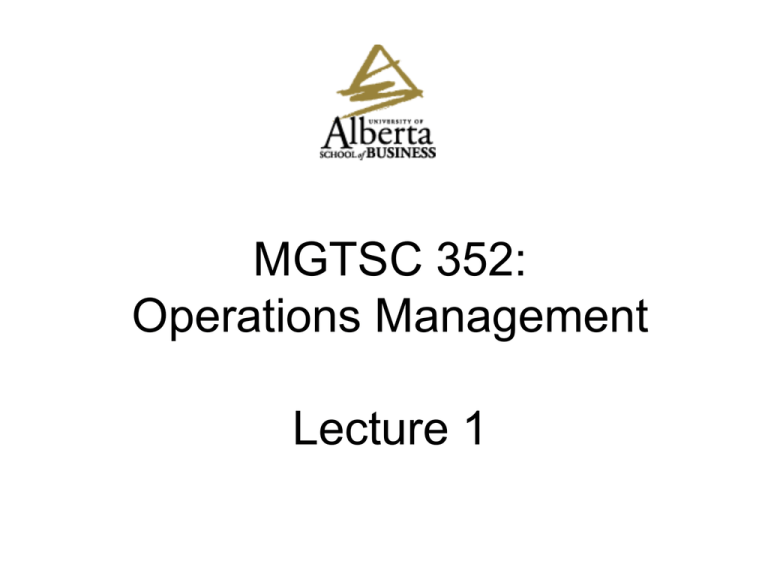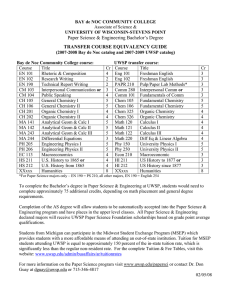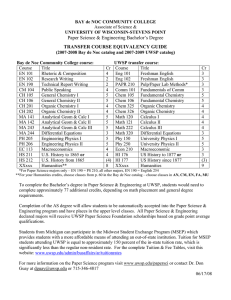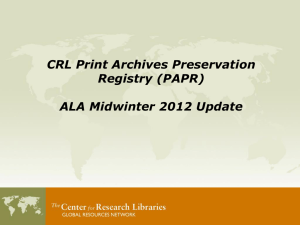Lecture 1 - University of Alberta
advertisement

MGTSC 352: Operations Management Lecture 1 My name is ... Kenneth Schultz Office 340G Business Telephone 492-3068 Email klschult This course is … … a continuation of MGTSC 312 Not ... Mgtsc != Stats “Traditional” University Course • Class – – – – Come to class (sometimes) Listen to The Prof (maybe not) Take notes (perhaps) Get bored • Study – Read the text (maybe not) – Memorize stuff (wondering why—maybe not) • Write exams – Sometimes multiple choice – Sometimes regurgitation This course • Class – Come to class, try to follow the lecture, participate – Come to lab/work on your own and try to repeat what was done in lecture • Study – Read the notes/text – Read/post to discussion forums – Do the HWs • Do exams (on-line) We want you to… • • • • • … think with us (lectures, labs) … interact with us … take initiative/responsibility … experiment aggressively … learn by DOING • This ain’t no sit-back-and-relax, you-paysyour-fees-and-you-gets-your-credits course. Evaluation 25% Assignments 25% Quizzes Best 8 out of 9 Must get 40% to pass (10 out of 25) Best 2: 10% each Worst one: 5% Must get 40% to pass (30 out of 75) 50% Final exam Grade Distribution • Similar to other 3rd / 4th year courses • Your relative mark is what matters Number of students MGTSC 352, Fall 2005 70 60 50 40 30 20 10 0 66 58 51 49 36 32 25 8 7 F D 4 21 9 D+ C- C C+ BGrade B B+ A- A A+ Active Learning • Form groups of two • Whose birthday is earlier in the year? – You’re the recorder • Question: What have you heard about this course? • Time: 1 minute Percent recall Why Active Learning? 100 90 80 70 60 50 40 30 20 10 0 0 5 10 15 20 Time spent lecturing (min.) 25 30 What is this course about? Production and delivery of … … goods and services • Forecasting • Simulation • Aggregate Planning • Distribution Planning • Inventory Management • Congestion Management Show me a chart Corporate Strategy Marketing Strategy Operations Strategy Finance Strategy Operations Management Operations: Inputs Parts Processes Planning People Plants Outputs Another Chart: the “Process View” Information structure Inputs Process Management Network of Activities and Buffers Outputs Goods Services Flow units (customers, data, material, cash, etc.) Labor & Capital Resources Example: Amazon.Com • Inputs: – Customer orders – Books, CDs – Packing material • Outputs – Shipped orders • Flow units – Customer orders – Cash – Books • Resources: – Capital: contact centres, warehouses – Labor: agents, orderpickers, web programmers – Inventory • Activities: Order taking, order filling, shipping • Process management: Warehouses, inventory, distribution, capacity. • Information structure: Transaction data for each order Active Learning • In your groups again • Task: fill in as much of the next slide as you can • Time: 2 minutes Example: Business School • Inputs: • Outputs: • Flow units: • Resources: – Capital: – Labor: • Activities: • Process management: • Information structure: Do I have to take this course? Majors that need 352 ASAP Majors that require 352 • Operations Management • Decision and Information Systems • Distribution Management • Accounting • Business Studies • Finance • International Business • Management Info. Systems • Marketing • Retailing Majors that do not require 352 • Business Economics and Law • Entrepreneurship and Small Business • Human Resource Management • ______ Studies (language programs) • Organizational Studies Who are we? • Instructor: Kenneth Schultz • Lab Masters: – Morgan Skowronski – Jen Tyrkalo • Grading: Jared Coulson • Tech Master: Angela Kercher • Lab Accelerators Kenneth Schultz • • • • Wharton Undergraduate 12 Years United States Army Ph.D. 1997, Cornell Research: Including human behavior in Operations Management models. My course priorities are: I’m fair You learn Morgan Skowronski Jen Tyrkalo Things To Do Before Next Class • Course web – Read the “things to do” page WINTER 2007 MGTSC 352 LEC B1 > COURSE DOCUMENTS > RESOURCES > GENERAL RESOURCES – Read FAQ WINTER 2007 MGTSC 352 LEC B1 > COURSE DOCUMENTS > RESOURCES > GENERAL RESOURCES > FREQUENTLY ASKED QUESTIONS – Get familiar with course web and discussion forums • Read Introduction chapter (Course pack) • Read syllabus Musical Break ... do not leave Excel Basics • Jan 20, 11 – 1, B24/B28 • Free • Basic Excel skills Course Packs • • • • $20 Today, 3-5 in B20 Wed, 10-12 in B20 Friday in labs Model • Selective abstraction of reality – Model airplane – Floor plan of a house – Map of Alberta • Spreadsheet (algebraic) models – Define decision cells (variables) – Express relations between cells (formulas) Inputs MODEL Revenue = Quantity x Price Output Inputs Outputs Why model? • • • • • Provides a precise and concise problem statement Establishes what data are necessary for decision Clarifies relationships between variables Enables the use of known solution methods Enables us to generalize knowledge to solve problems we haven’t encountered before, to go beyond experiential learning. Example Fisheries Management • • • • • Lake currently has 1,000 trout Carrying capacity = 100,000 trout Fish population expands in May and June Fishing allowed in September Trout population at end of August: PAug = PApr + (a – (b PApr)) PApr), a = 0.45, b = a / capacity. • Each fish can be sold for $11 in any year • Discount rate is 6%. • Which policy maximizes the NPV? Come again? May population = 12,000 August population? b = a / Cap = .45 / 100,000 PAug = PApr + (a – b PApr) PApr) =? In your groups! Time: 1 min. Come again? May population = 12,000 August population? b = a / Cap = .45 / 100,000 PAug = PApr + (a – b PApr) PApr) = 12,000 + (0.45 – (0.45 / 100,000 12,000)) 12,000 = 12,000 + (0.396)*12,000 = 16,752 Recap • Data – Starting population – Capacity – Growth parameter (a) – Discount rate – Price • Variables: # of fish caught, for every year. • Output: NPV (and fish population every year)











